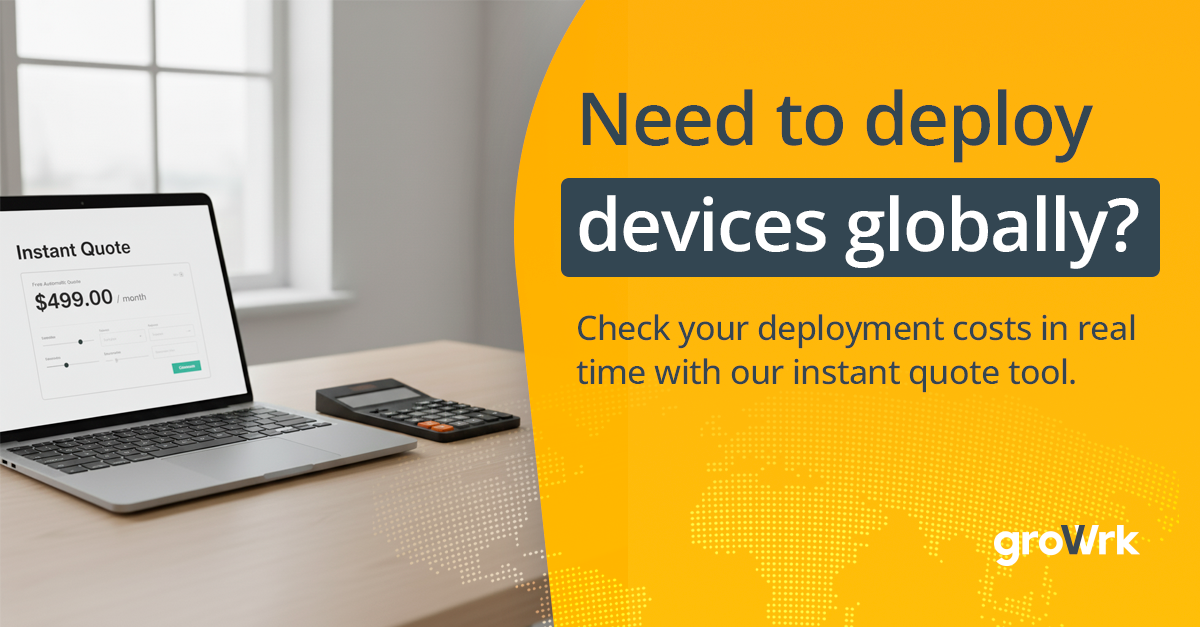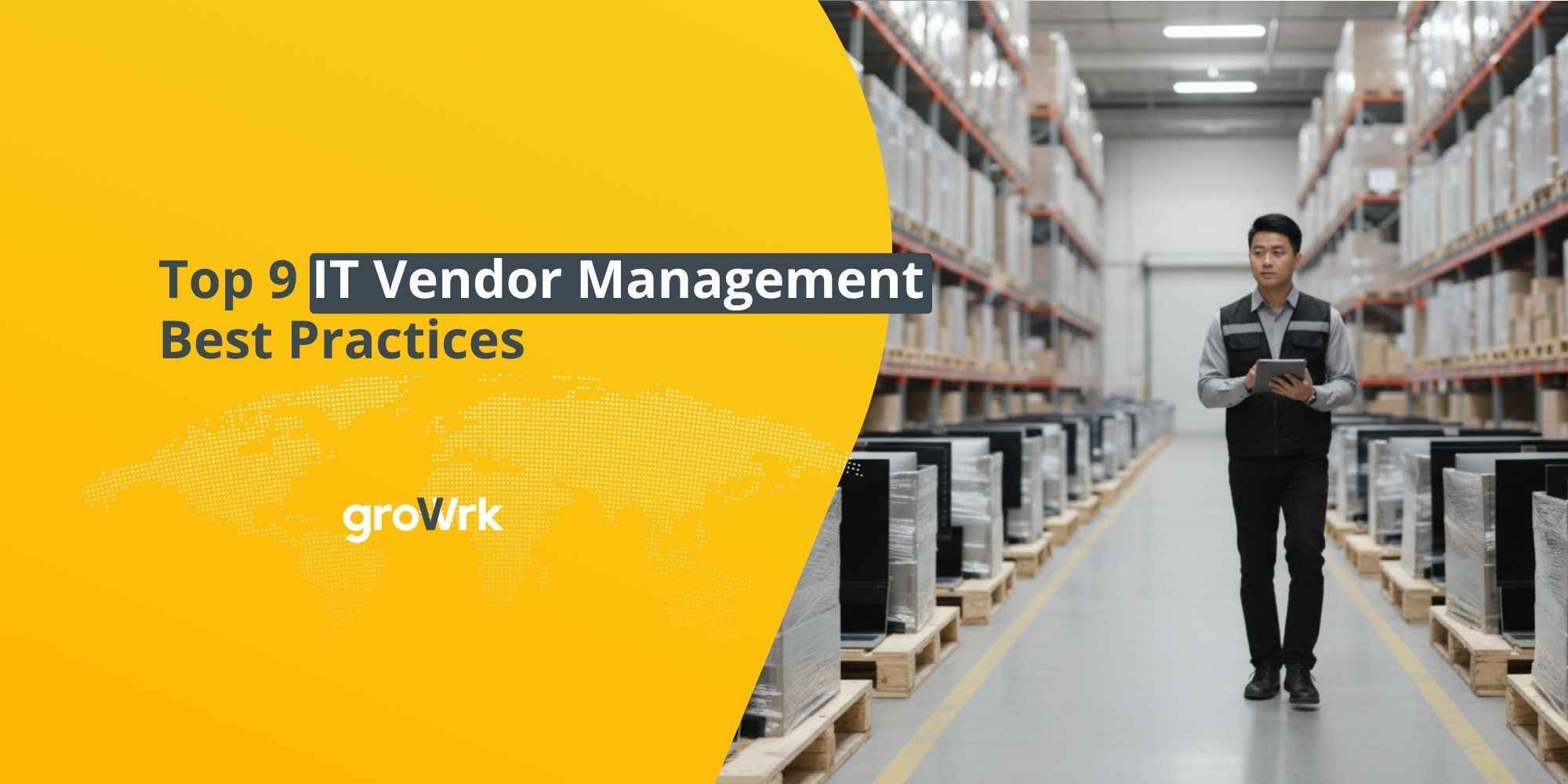IT Hardware Procurement: A Strategic Framework for 2025
 GroWrk Team
GroWrk Team
IT Hardware Procurement is critical for maintaining an efficient IT infrastructure. According to a static Gartner report, global IT spending is expected to reach approximately $5.26 trillion annually, marking a 7.5% increase from 2023. With this data, it is clear that IT business operators must ensure their hardware procurement is cost-effective and meets their references.
This guide covers evaluating business needs, conducting market research, selecting vendors, emphasizing the importance of vendor management to streamline operations, and lifecycle management. You’ll learn best practices for cost-effective purchases, vendor relationships, and ensuring compatibility and security.
Key takeaways
-
A structured IT Hardware Procurement process saves money, simplifies operations, and builds good relationships with vendors.
-
Steps to the entire process include business needs, market research, standardization, and automation.
-
Effective vendor management and lifecycle management are essential for maximizing the value of IT hardware and ensuring compliance with security regulations.
Understanding IT Hardware Procurement in 2025

IT Hardware Procurement services involve acquiring and managing technology assets and infrastructure, a fundamental aspect of any organization’s technology strategy. The hardware procurement includes a series of activities, such as sourcing and evaluating vendors, negotiating contracts, and ensuring compliance with organizational policies.
A structured approach to IT procurement effectively evaluates, acquires, and manages technology resources. This approach cuts costs, reduces risks, maximizes IT spending returns, and improves SaaS purchasing and technology acquisition efficiency.
Get an instant quote
Benefits of a structured IT Hardware Procurement Process
Having a structured IT hardware procurement process offers numerous advantages. It ensures cost-effective solutions, enhances operational efficiency, strengthens relationships with vendors, maintains system compatibility, promotes standardization and enhances security.
Let’s delve into each of these benefits.
Cost-effective solutions
A structured procurement strategy aligns hardware purchases with budget constraints and managing expenses. Access to specialized hardware procurement services helps companies save costs and find better suppliers. This strategy reduces financial constraints on IT procurement while aligning technology investments with business goals.
Enhancing operational efficiency
A well-defined procurement service process reduces operational costs by minimizing waste and ensuring efficient spending. Streamlining procurement activities leads to greater operational efficiency, helping to alleviate administrative burdens and improve productivity in your IT department. External procurement suppliers can enhance efficiency and reduce delays.
Strengthening vendor relationships
Establishing strong vendor partnerships can facilitate better support and integration of new technologies into existing systems. A structured hardware procurement ensures compliance with purchasing policies, which is crucial for strong relationships. This enhances operational efficiency and ensures reliable support from trusted vendors.
Systems compatibility and interoperability
Systems compatibility is vital for integrating new hardware with existing technology infrastructure. Interoperability among different hardware components improves overall system performance and reduces operational disruptions.
Assessing compatibility during IT procurement can prevent costly integration issues later in the lifecycle of IT hardware.
Standardization
Implementing standardized hardware across an organization promotes consistency, simplifies troubleshooting, and streamlines IT support processes. Standardization ensures that all components work harmoniously, enhancing operational efficiency and reducing the complexity of managing diverse hardware setups.
Enhanced security
Hardware with built-in security features and timely updates protects against cyber threats and data breaches. This proactive approach to hardware security is essential in today’s threat landscape to ensure data is secure and compliant with regulatory standards.
Best practices involved in the IT Hardware Procurement process

The IT Hardware Procurement involves several key steps. A well-structured procurement management process can significantly reduce costs through bulk purchasing and vendor negotiations. Let’s break down these steps in detail.
1. Identifying business needs
The first step in an effective IT Hardware Procurement is identifying business needs. A thorough needs assessment is crucial for identifying specific IT requirements and gaps in the current tech stack. Consulting stakeholders align technology acquisitions with business objectives and ensure cost-effectiveness.
2. Conducting market research
Supplier research includes market analysis to evaluate potential vendors’ offerings and capabilities. Researching the market should assess vendor offerings, compare features and prices, and ensure compatibility with current systems. Shortlisting vendors based on specified criteria helps eliminate those not aligned with project budgets or essential features.
3. Make standardization guidelines
Developing a set of standardization guidelines ensures consistency across your IT hardware ecosystem. This includes defining hardware specifications and configurations, selecting preferred brands and models, establishing refresh cycles, and implementing a centralized asset management system.
4. Leverage global delivery and logistics
For global workforce IT Procurement, partnering with a provider like GroWrk with strong transport connections across 150+ countries ensures efficient delivery and logistics management. Look for solutions that provide centralized procurement and inventory management, offer fast and reliable delivery to distributed offices worldwide, handle customs clearance, and provide flexible options for stock management and warehousing.
5. Check security and customization options
Hardware should meet security standards and be customizable to fit specific team requirements. Look for built-in security features such as encryption and biometric authentication, compatibility with existing security policies, and customization options for storage, memory, and peripherals.
6. Incorporate automation into your systems
Automate and use self-service tools to simplify IT procurement and empower employees. Implement a self-service portal for hardware requests and approvals, automate asset tracking and inventory management, integrate procurement systems with your IT service management platform, and provide a wide catalog of pre-approved hardware options.
7. Making informed decisions
Each IT procurement phase requires stakeholder input to align technology acquisitions with overarching corporate strategies. Consult stakeholders and conduct thorough vendor vetting when considering potential solutions. This includes assessing each supplier’s financial stability and ability to meet technical specifications.
Evaluating and selecting vendors for IT Hardware Procurement

Evaluating and selecting vendors is a critical component of specialized IT vendor management. Consulting stakeholders during the evaluation ensures that decisions align with organizational goals.
Analyzing IT procurement data and engaging with stakeholders enhances the decision-making process regarding technology acquisitions. Effective vendor management can simplify the evaluation process by consolidating vendor information and streamlining decision-making.
Vendor vetting and risk analysis
Vendor risk analysis ensures regulatory compliance and mitigates potential data breaches. The vendor vetting process involves assessing each supplier for various criteria to determine suitability. Considerations such as budget, non-negotiable features, and integration capabilities are critical when vetting a vendor.
Negotiating contracts
Negotiating volume discounts lowers IT hardware purchase prices. Forming strong partnerships with vendors can lead to improved service quality and better pricing options. Negotiations should cover essential elements such as deliverables, pricing, and performance specifications to secure advantageous terms. The IT vendor best practices that you choose will impact your bottom line.
Managing the lifecycle of your IT Hardware

Managing the lifecycle of IT hardware includes stages like planning, procurement, deployment, management, and decommissioning to give you a competitive advantage. Proper IT hardware lifecycle management maximizes value and minimizes operational disruptions.
Asset management
Effective asset management ensures continuous IT equipment tracking and maintenance, optimizing its usage over its entire lifecycle. This involves keeping an accurate inventory of IT components, including their specifications and end-of-life dates.
Disposal and recycling
Proper disposal of IT hardware includes changing the asset’s status to expired or disposed and ensuring that associated software tools are unallocated. Creating a detailed inventory of recycled assets is essential for cost savings, as it helps track and manage the disposal process effectively.
Ensuring data security in IT Hardware Procurement

Encrypting data during transfer and storage safeguards sensitive information from unauthorized access. Implementing strong access controls limits data visibility to only those who need it, thereby reducing the risk of data threats.
Compliance with data protection regulations is crucial for safeguarding personal information and avoiding legal issues.
Preventing redundancies and Shadow IT
Preventing redundancies and shadow IT is vital for maximizing investment on technology needs and minimizing waste. Redundancies arise when multiple tools or devices perform similar functions, leading to unnecessary costs and inefficiencies, while shadow IT refers to the use of unauthorized software or hardware, posing security risks.
A robust IT procurement is essential to tackle these issues, starting with a thorough needs assessment to identify specific requirements and technological infrastructure gaps. Key actions include conducting comprehensive research on the market to evaluate vendors, auditing existing systems to pinpoint redundancies, and establishing clear technology adoption and usage policies. Many organizations can boost operational efficiency, reduce costs, and improve their overall technology posture by ensuring employees understand the risks of shadow IT and adhere to approved IT procurement processes.
Leveraging specialized IT Hardware Procurement solutions
Specialized IT Hardware Procurement services streamline the process, enabling efficient navigation of complex tasks and seamless integration into existing systems. These services can save significant costs by optimizing purchasing processes and using vendor connections. They also improve operational efficiency by reducing the time and resources needed for market and vendor research.
Wrapping Up
A structured IT Hardware Procurement process is vital in today’s digital landscape. It ensures cost-effective solutions, enhances operational efficiency, strengthens multiple vendor relationships, maintains system compatibility, promotes standardization, and enhances security. By following the best practices outlined in this guide, organizations can optimize their investment in technology and improve overall performance.
As you refine your IT procurement strategies, remember that the key to business operations success lies in careful planning, informed decision-making, and leveraging specialized services from top procurement leaders like GroWrk. We cover every stage of the IT hardware asset lifecycle, from procurement to disposal. Sign up for a free demo and access the largest IT asset procurement and retrieval network in the world.
Frequently Asked Questions
What are the key steps in the IT Hardware Procurement process?
The key steps in the IT Hardware Procurement process involve identifying business needs, conducting market and competitors research, establishing standardization guidelines, leveraging global logistics, assessing security and customization options, incorporating automation, and making informed decisions. This structured approach ensures that procurement aligns with organizational objectives and enhances efficiency.
How can a structured IT procurement process enhance operational efficiency?
A structured procurement process enhances operational efficiency by minimizing waste, ensuring effective spending, streamlining administrative tasks, and utilizing external suppliers effectively. This approach leads to more optimal resource management and overall productivity.
What are the benefits of strengthening vendor relationships?
Strengthening vendor relationships enhances operational efficiency by facilitating better support, integration of new technologies, and compliance with purchasing policies. This collaborative approach ultimately leads to improved business outcomes.
Why is ensuring systems compatibility important?
Ensuring systems compatibility is essential as it prevents costly integration issues and enhances overall system performance, thereby minimizing operational disruptions. This ultimately leads to more efficient processes and increased productivity.







